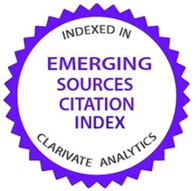Redes de defensa voluntarias en preparación ante emergencias en países desarrollados: el caso de Suecia
DOI:
https://doi.org/10.21830/19006586.379Palabras clave:
actores de la sociedad civil, comunicación, coordinación civil-militar, eficiencia de gestión, preparación para emergencias, redes de defensa voluntariasResumen
Las redes voluntarias son actores de la sociedad civil e importantes para la eficiencia en la preparación de emergencia de los países desarrollados. Este estudio es sobre las redes de defensa voluntarias en Suecia, un conjunto único de redes voluntarias que contribuyen a la eficiencia de la preparación para emergencias. Las entrevistas con expertos en el campo civil y militar sueco y sus redes de defensa voluntarias asociadas y datos secundarios expusieron el examen de la coordinación de la red de defensa voluntaria en la práctica. La coordinación voluntaria de la red está significativamente asociada con la eficiencia, pero en la práctica, la mayoría de las redes voluntarias no están bien coordinadas. Si los profesionales civiles y militares de los países desarrollados están luchando con la coordinación de redes voluntarias, este estudio confirma que no son únicos en su lucha. La práctica indiferente es de hecho la norma. Los profesionales civiles y militares pueden seguir una ruta adecuada aquí establecida cuando se busca mejorar la eficiencia de la respuesta de emergencia.
Descargas
Referencias bibliográficas
Alvesson, M., Lee Ashcraft, K., & Thomas, R. (2008). Identity matters: Reflections on the construction of identity scholarship in organization studies. Organization, 15(1), 5-28.
Alexander, D. (2005). Towards the development of a standard in emergency planning. Disaster Prevention and Management, 14(2), 158-175.
Axelsson, B., & Easton, G. (1992). Industrial Networks: A New View of Reality: Routledge, New York, 10017.
Birkland, T. A. (2009). Disasters, lessons learned, and fantasy documents. Journal of Contingencies and Crisis management, 17(3), 146-156.
Boin, A., Hart, P. t., Stern, E., & Sundelius, B. (2005). The politics of crisis management. Cambridge, UK: Cambridge University Press.
Boin, A., & Lagadec, P. (2000). Preparing for the future: Critical challenges in crisis management. Journal of Contingencies and Crisis management, 8(4), 185–191.
Bower, R. T., & Gasparis, P. (1978). Ethics in social research: Protecting the interests of human subjects (Vol. 23). New York, NY: Praeger Publishers.
Brudney, J. L., & Gazley, B. (2009). Planing to be prepared: an empirical examination of the role of voluntary organizations in county government emergency planning. Public Performance & Management Review, 32(3), 372-399
CRD. (2009). Systematic reviews: CRD’s guidance for undertaking reviews in health care: University of York, Centre for Reviews & Dissemination.
Clark, J. (2007). Voluntary sector skills survey. University of Warwick, Coventry, UK: NCVO Annual Research Conference.
Comfort, L. K. (1994). Risk and Resilience: Inter‐organizational Learning Following the Northridge Earthquake of 17 January 1994. Journal of Contingencies and Crisis management, 2(3), 157-170.
Comfort, L. K. (2005). Risk, Security, and Disaster Management. Annual Review of Political Science, 8, 335–356.
Comfort, L. K., & Haase, T. W. (2006). Communication, coherence, and collective action: The impact of Hurricane Katrina on communications infrastructure. Public Works management & policy, 10(4), 328-343.
Cross, T. (2012). Disaster agencies and military force–not such strange bedfellows after all! In M. Christopher & P. Tatham (Eds.), Humanitarian logistics: Meeting the challenge of preparing for and responding to disasters (pp. 233-248). London, UK: Kogan Page.
Eisenhardt, K. M., & Graebner, M. E. (2007). Theory building from cases: Opportunities and challenges. Academy of Management Journal, 50(1), 25-32.
Feaver, P. D. (1996). The civil-military problematique: Huntington, Janowitz, and the question of civilian control. Armed Forces & Society, 23(2), 149-178.
Fenton, N., Passey, A., & Hems, L. (1999). Trust, the voluntary sector and civil society. International Journal of Sociology and Social Policy, 19(7/8), 21-42.
Gadde, L.-E., Huemer, L., & Hakansson, H. (2003). Strategizing in industrial networks. Industrial Marketing Management, 32(5), 357-364.
Gadde, L. E., Hakansson, H., Jahre, M., & Persson, G. (2002). “More instead of less” - Strategies for the use of logistics resources. Journal on Chain and Network Science, 2(2), 81-91.
Golafshani, N. (2003). Understanding Reliability and Validity in Qualitative Research. The Qualitative Report, 8(4), 597-606.
Grant, M. (2010). After the bomb: Civil defence and nuclear war in Britain, 1945-68. Basingstoke, UK: Palgrave Macmillan.
Guba, E. G., & Lincoln, Y. S. (1994). Competing paradigms in qualitative research. Handbook of qualitative research, 2(163-194), 105.
Heaslip, G., & Barber, E. (2014). Using the military in disaster relief: systemising challenges and opportunities. Journal of Humanitarian Logistics and Supply Chain Management, 4(1), 60-81.
Heaslip, G., Sharif, A. M., & Althonayan, A. (2012). Employing a systems-based perspective to the identification of inter-relationships in humanitarian logistics International. Journal of Production Economics, 139(2), 377-392.
Helsloot, I. (2005). Bordering on reality: Findings on the bonfire crisis management simulation. Journal of Contingencies and Crisis management, 13(4), 159-169.
Hunt, S., Smith, K., Hamerton, H., & Sargisson, R. J. (2014). An incident control centre in action: response to the Rena oil spill in New Zealand. Journal of Contingencies and Crisis management, 22(1), 63-66.
Hakansson, H. (1988). Corporate Technological behaviour: Co-operation and networks London, UK: Routledge.
Hakansson, H., & Johanson, J. (2002). A model of industrial networks. In D. Ford (Ed.), Understanding business markets (pp. 145-149). London, UK: Thomson Learning.
Hakansson, H., & Snehota, I. (2006). No business is an island: The network concept of business strategy. Scandinavian Journal of Management, 22(3), 256-270.
Jahre, M., Jensen, L.-M., & Listou, T. (2009). Theory development in humanitarian logistics: a framework and three cases. Management Research News, 32(11), 1008-1023.
Kaldor, M. (2003). Global civil society: An answer to war. Cambridge, UK: Polity.
Kaneberg, E., Hertz, S., & Jensen, L. M. (2016). Emergency preparedness planning in developed countries: the Swedish case. Journal of Humanitarian Logistics and Supply Chain Management, 6(2), 145-172.
Kendall, J. (2003). The voluntary sector. London, UK: Routledge.
Korlof, B., Lagerblad, P., Lundgren, B. R., & Wahlberg, I. (2014). Var behi: ivs frivilligheten? Arlig redovisning fran KKrVA: Kungl Krigsvetenskapsakademien.
L’Hermitte, C., Bowles, M., Tatham, P., & Brooks, B. (2015). An integrated approach to agility in humanitarian logistics. Journal of Humanitarian Logistics and Supply Chain Management, 5(2), 209-233.
Lalonde, C. (2007). The potential contribution of the field of organizational development to crisis management. Journal of Contingencies and Crisis management, 15(2), 95-104.
Lundstrom, T., & Svedberg, L. (2003). The voluntary sector in a social democratic welfare state–The case of Sweden. Journal of Social Policy, 32(2), 217-238.
McConnell, A., & Drennan, L. (2006). Mission impossible? Planning and preparing for crisis. Journal of Contingencies and Crisis management, 14(2), 59-70.
Merchant, R. M., Elmer, S., & Lurie, N. (2011). Integrating social media into emergency-preparedness efforts. New England Journal of Medicine, 365(4), 289-291.
Meyer, C. O. (2009). International terrorism as a force of homogenization? A constructivist approach to understanding cross-national threat perceptions and responses. Cambridge Review of International Affairs, 22(4), 647-666.
Mikkelsen, M. (2006). Policy network analysis as a strategic tool for the voluntary sector. Policy Studies, 27(1), 17-26.
Nolte, I. M., & Boenigk, S. (2011). Public–nonprofit partnership performance in a disaster context: The case of Haiti. Public Administration, 89(4), 1385-1402.
Nugroho, Y. (2011). Opening the black box: The adoption of innovations in the voluntary sector—The case of Indonesian civil society organisations. Research Policy, 40(5), 761-777.
Osborne, S. (2002). Public-private partnerships: Theory and practice in international perspective: Routledge.
Park, S. H. (1996). Managing an interorganizational network: a framework of the institutional mechanism for network control. Organization Studies, 17(5), 795-824.
Parker, C. F., Stern, E. K., Paglia, E., & Brown, C. (2009). Preventable catastrophe? The hurricane Katrina disaster revisited. Journal of Contingencies and Crisis management, 17(4), 206-220.
Parker, R., & Bradley, L. (2000). Organisational culture in the public sector: evidence from six organisations. International Journal of Public Sector Management, 13(2), 125-141.
Perrow, C. (2007). The next catastrophe: Reducing our vulnerabilities to natural, industrial, and terrorist disasters. Princeton, NY: Princeton University Press.
Perry, R., & Lindell, M. (2003). Preparedness for Emergency Response: Guidelines for the Emergency Planning Process. Disasters, 27(4), 336––350.
Plowden, W. (2003). The Compact: Attempts to Regulate Relationships between Government and the Voluntary Sector in England. Nonprofit and Voluntary Sector Quarterly, 32(3), 415-432.
Rimstad, R., Nja, O., Rake, E. L., & Braut, G. S. (2014). Incident command and information flows in a largescale emergency operation. Journal of Contingencies and Crisis management, 22(1), 29-38.
Rotolo, T., & Berg, J. A. (2010). In Times of Need: An Examination of Emergency Preparedness and Disaster Relief Service Volunteers. Nonprofit and Voluntary Sector Quarterly, 40(4), 740-750.
Salamon, L. M. (1995). Partners in public service: Government-nonprofit relations in the modern welfare state: JHU Press.
Salamon, L. M., & Helmut, K. A. (1992). Toward an understanding of the international nonprofit sector: The Johns Hopkins Comparative Nonprofit Sector Project. Nonprofit Management & Leadership, 2(3), 311-324.
Samuelson, A. (2005). Militärt stöd till samhället. Lund, Sweden: Department of Fire Safety Engineering, Lund University.
Sivesind, K. H., Lorentzen, H., Selle, P., & Wollebak, D. (2002). The voluntary sector in Norway: Composition, changes, and causes (Vol. 2). Oslo, Norway: Institutt for samfunnsforskning.
Smith, P. C., & Laage-Hellman, J. (1992). Small group analysis in industrial networks. In B. Axelsson & G. Easton (Eds.), Industrial networks: A new view of reality. London, UK: Routledge.
Statistics Sweden. (2015). The civil society 2013: Satellite accounts and surveys. Stockholm, Sweden: Statistics Sweden, Business Structure Unit.
Steets, J., & Hamilton, S. (2009). Humanitarian assistance: EU-US-cooperation. Washington, DC: Global Public Policy Institute.
Steigenberger, N. (2016). Organizing for the Big One: A Review of Case Studies and a Research Agenda for Multi‐Agency Disaster Response. Journal of Contingencies and Crisis management, 24(2), 60-72.
Stephenson, M. (2007). Bridging the organizational divide: A comparative institutional analysis of United States and international humanitarian service delivery structures. Voluntas: International Journal of Voluntary and Nonprofit Organizations, 18(3), 209-224.
Stromberg, I. (2015). Rapport från skogsbrandsutredningen. Stockholm, Sweden: Justitiedepartementet.
Tomasini, R. M., & Van Wassenhove, L. N. (2009). From preparedness to partnerships: case study research on humanitarian logistics. International Transactions in Operational Research, 16(5), 549-559.
Van Wassenhove, L. N. (2006). Blackett Memorial Lecturew: Humanitarian aid logistics: supply chain management in high gear. Journal of the Operational Research Society, 57(5), 475-489. doi: 10.1057/palgrave.jors.2602125
Waugh, W. L., & Streib, G. (2006). Collaboration and leadership for effective emergency management. Public Administration Review, 66(1), 131-140.
Wijkstrom, & Einarsson, T. (2006). Från Nationalstat till Näringsliv? Det civila samhällets organisationsliv iförändring. Stockholm, Sweden: Ekonomiska forskningsinstitutet (EFI), Handelshogskolan i Stockholm.
Wijkstrom, F. (2000). Changing focus or changing role? The Swedish nonprofit sector in the 1990s German Policy Studies, 1(2), 161-188.
Wolbers, J., & Boersma, K. (2013). The common operational picture as collective sensemaking. Journal of Contingencies and Crisis management, 21(4), 186-199.
World Bank (2016). “Taking on Inequality.” International Bank for Reconstruction and Development.” Washington, DC 20433. Internet: www.worldbank.org
World Bank (2017). “Global Economic Prospects: Weak Investment in Uncertain Times.” International Bank for Reconstruction and Development. Washington, DC 20433 Internet: www.worldbank.org.
Wyman, J. S. (2009). Emergency management in Scandinavia: FEMA Higher Education Conference, Humanitarian & Disaster Relief Logistics Application Division.
Yin, R. (2002). Case study research: Design and methods (Vol. 5). Thousand Oaks, CA: Sage Publications.
Young, D. R. (2000). Alternative models of government-nonprofit sector relations: Theoretical and international perspectives. Nonprofit and Voluntary Sector Quarterly, 29(1), 149-172.
Odlund, A. (2010). Pulling the Same Way? A Multi‐Perspectivist Study of Crisis Cooperation in Government. Journal of Contingencies and Crisis management, 18(2), 96-107.
Descargas
Publicado
Cómo citar
Número
Sección
| Estadísticas de artículo | |
|---|---|
| Vistas de resúmenes | |
| Vistas de PDF | |
| Descargas de PDF | |
| Vistas de HTML | |
| Otras vistas | |

























